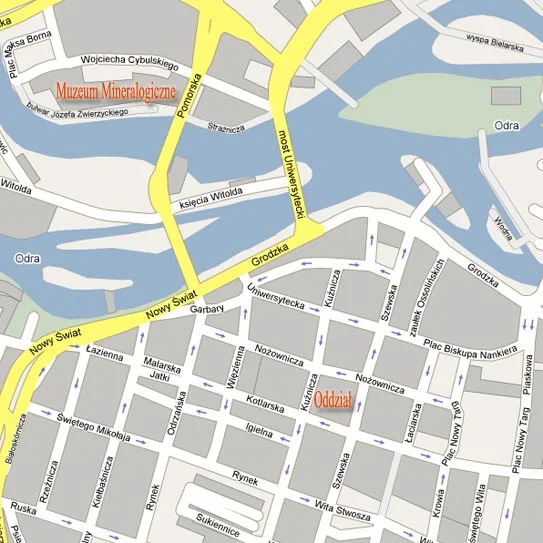
Mineralogical Museum
Attention!
As of March 1, 2022, Branches of the Mineralogical Museum will be open only to individual visitors. The possibility of guided tours will remain temporarily unavailable.
Addresses
Mineralogical Museum
ul. Cybulskiego 30
50-205 Wrocław
tel. (071) 3759206
Branch of the Mineralogical Museum
ul. Kuźnicza 22
50-138 Wrocław
tel. (071) 3752668
e-mail address: muz.min@uwr.edu.pl
Opening hours
ul. Cybulskiego 30
Monday – Friday from 10.00 to 15.30
ul. Kuźnicza 22
Monday – Saturday from 10.00 to 15.30.
Ticket prices and other fees
normal ticket – PLN 10
reduced ticket – PLN 5 (schoolchildren, students, retirees, pensioners)
family ticket – PLN 20 (2 adults and at least 2 minors)
fee for a guided tour – PLN 50

History of the Museum
The establishment of a secular university in Wrocław in 1811 marked the beginning of the Chair of Geognosy (as geology was called back then) and the Mineralogical Cabinet as its auxiliary workshop. Professor Karol von Raumer was appointed as the head of the Cabinet. The initial collection was an incomplete set of minerals from the Higher Mining Office in Wrocław, which was transformed in 1812 into a small set for educational purposes placed in a rented space. Further development of the Mineralogical Cabinet occurred in 1815 when an excellent collection was purchased from the collector Mender from Freiberg. Over the following years, the collections expanded with minerals, rocks, and fossils, primarily from Lower Silesia, due to the growth of geological research conducted at the University of Wrocław and collaboration with the Higher Mining Office in Wrocław. A very valuable collection of Silesian minerals was donated by Prof. Martin Websky, a graduate of Wrocław’s geology. Due to the dynamic development of the Cabinet, it was renamed the Mineralogical Museum of the University of Wrocław in 1880 and became an independent scientific institution in 1897.
At the end of World War II, to protect the collections, they were evacuated from Wrocław and deposited in churches in Strzegom and Świerzawa. After the war and the assumption of control over the University of Wrocław by Polish authorities in 1946, efforts by Prof. Kazimierz Maślankiewicz and Assoc. Prof. Edward Zubik led to the retrieval of the mineral collection stored in Świerzawa. Meanwhile, the collection from Strzegom was transported to Warsaw and incorporated into the collection of the Museum of the Earth, Polish Academy of Sciences. Until 1961, only temporary work was done on organizing the specimens. The following years of hard work by the team under the direction of Dr. Maria Witkiewicz and Mr. Michał Sachanbiński allowed the Mineralogical Museum’s collections to be opened and made available to the public in June 1966.
Currently, the collections of the Mineralogical Museum consist of approximately 30,000 mineral specimens from around the world. The foundation of these collections dates back to the specimens gathered before 1945. The post-war years saw the addition and enrichment of the collections with new specimens, primarily collected from the territory of Poland.
Employees of the Mineralogical Museum
– dr hab. prof. UWr. Piotr Kazimierz Gunia – manager
– Joanna Girulska-Michalik, MSc.– senior specialist geologist
– dr. Edyta Łobocka– senior specialist geologist
– Jacek Bogdanski, MSc. – senior specialist geologist
– Antoni Stryjewski, MSc.– senior documentalist
